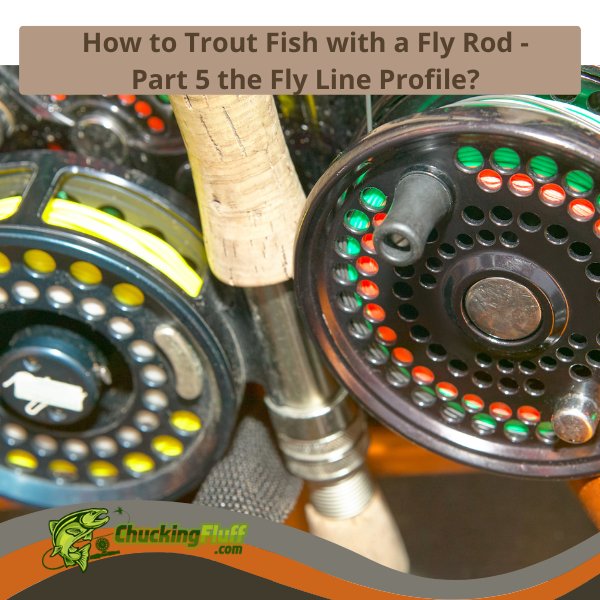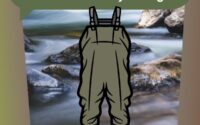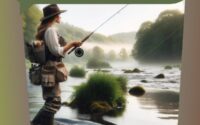| Disclosure: Just to be open and honest the buttons and links you click on in the website will in most cases take you to another website where you can purchase the products I am reviewing. As an Amazon Associate I earn from qualifying purchases. |
How to Trout Fish with a Fly Rod – Part 5 the Fly Line Profile

In the last post, we discussed some of the physical attributes of fly lines.
These included color, density and weight.
Fly lines have a lot more going on than these including front taper, head, back taper, belly, and running line.
These characteristics are mostly to do with the aerodynamics of the fly line how it handles in the air when casting etc.
Some of these characteristics also affect the handling when in the water for retrieval etc we will discuss these and look at what types of lines to look for when fishing different locations and water types.
The fly line is made from one continuous piece of core line covered with different layers of polymers to create the different line densities.
These polymers are laid down to create a thickening of the line as it progresses from the tip until its thickest part then it tapers down again until the end of the line.
The differences in these tapers have been developed to produce new types of fly line.

Quick Post Navigation
What are Double Taper Fly Fishing Lines?
A line that has the same taper length from both ends was the original line and is known as the double taper (DT) and was a favorite of fly anglers worldwide in its ability to roll cast very well on small rivers and streams.
The other advantage was you could turn the line around after a few seasons and use it from the other end prolonging the life of the line and keeping costs down.
These lines had all but disappeared from the manufactures products lists a few years ago in favor of new weight forward tapers but are making a good comeback as a great trout line for close casting mending and boat nymph fishing.
The manufactures who do decent Double Taper lines are Cortland, Rio, and Scientific Anglers.
Another great use of double taper lines is using them for Czech nymphing.
A method using a 9ft rod with a 5 weight line and holding the line out over the water and bouncing a nymph fly across the bottom of a stream or river.
A great technique for trout.
Options of taper of the head on the fly line
Other options in taper are when the main weight of the line is pushed further towards the front section of the line.
The more to the front the faster the line shoots from the rings and these are known as shooting headlines.
Long taper lines are where the weight is sitting in the middle and are great for spey casting on large rivers when you want to be able to air mend and water mend the line during casts.
A mend is a gentle flick up or downstream with the rod to change the direction of the line during a cast or when on the water.
This mend is used to avoid obstacles or speed up or slow down the line as it drifts in the current.
Another technique to master when learning to fly fish and will help you catch many more fish.
If you have ever fished a shooting head in a large river cast your line then wanted to mend upstream you will know it is impossible to do.
The running line is just too flimsy to carry the mend up the line to the tip and resulting in a wiggle midstream.
Next, you have a weight forward (WF) taper which moves the weight of the line forward and leaves a thinner line behind it, or what is known as the running line.
These lines are good for getting better distance when casting and are a firm favorite with still-water anglers and boat anglers.
As the weight is further forward it makes the task of loading the rod easier for better casting.
To do the same thing with a double taper line you would have to handle a lot more line out from the tip ring and this is something that can be quite tricky to do for anyone but advanced fly anglers. 
What does a Shooting Head Fly line do?
Then coming from this moving the weight further forward we now have a shooting head which leaves a smaller head and more running line.
These are for better distances and are great for shooting large flies out into wide rivers and lakes.
Shooting heads now come as a separate entity from the running line and can be switched up or down in density to suit the particular pool or location you are fishing example changing from a full floater head to an intermediate or slow sinking to suit the pool.

These lines can be changed out very fast as they usually come with loops already made and a simple loop-to-loop connection is all that is required…no tying and re-tying knots here.
There are also multi-tip fly lines on the market that come with a wallet for storing several tips or shooting heads from full floating to fast sinking.
All good tools for the fly angler to use when the situation changes.
I find these lines are great for Salmon and other larger species.
I prefer a traditional weight forward line for trout though as presentation is more important.

What is a Skagit Fly fishing Line?
Then next comes the fastest line the Skagit which has the weight further to the front and is a great line for casting in tight spots with little or no back-cast.
The thing about these shooting heads is they will get you distance but are absolutely useless in presentation and mending.
These are good for shooting large tube flies and the like out into fast-flowing water but do take a bit of line management.
With shooting heads and Skagit lines, you need to retrieve the whole line back into the rod until the head section is either just inside the tip ring or close to it.
This means a lot of casting and retrieving and can be frustrating for some anglers and can be monotonous.
A bit of Presentation and Line Management
The fact you have to pull the whole line into you again means you have a lot of line lying free at your feet or flowing away from you downstream if fishing in a river.
Trying to re-cast this free line is very tricky and takes time to get used to.
You will find that the line gets tangled on vegetation, rocks, your feet and together causing lots of trouble.
The way to minimize this is to manage the line in long loops on your fingers and as you cast you release the loops one at a time as the cast hurls out over the water.
It takes a bit of practice and some time to master but when you get the hang of it shooting line can be fun and offers the fly fishing angler an option to reach fish on large rivers or lakes.
As mentioned above the presentation on these lines is non-existent so is no good for easily spooked fish.
However, if you can attach a tapered leader of a longer length than normal (usually the rod length) and get it to unfurl during the cast you can get a decent compromise between distance and presentation.
Conclusion on Fly Line Profiles
So it is really down to the location of the target species and your ability as to which line is best suited to the situation.
As a beginner, I would recommend a weight forward line that offers the ability to fish close and for extra distance which can be mended in the air and on the water and gives a good presentation.
These lines will give you a decent start and as you progress your skills you can explore other line profiles like shooting heads and Skagit lines etc.
Fly fishing is a continuous learning game that keeps us fly anglers busy trying new techniques so it never becomes boring.
If you are prepared to get stuck in and try the possibilities you will find the sport very exciting.




Hi Mark,
Another great installment. I said it before and I’ll say it again, I really had no idea there was so much involved in fishing!
With all the above information, what profile would you recommend the newbie to run with?
Hi Colm starting out I would recommend the basic weight forward full floating line. Its easy to cast and fish so you can practice and learn how to cast the fly onto the water. Then when you have mastered the timing and control of that line you can progress into shooting heads and skagit lines as these need more line management control and faster timing control. All skills that come with time and patience.